berger测试机简易培训
- 格式:ppt
- 大小:1.51 MB
- 文档页数:26
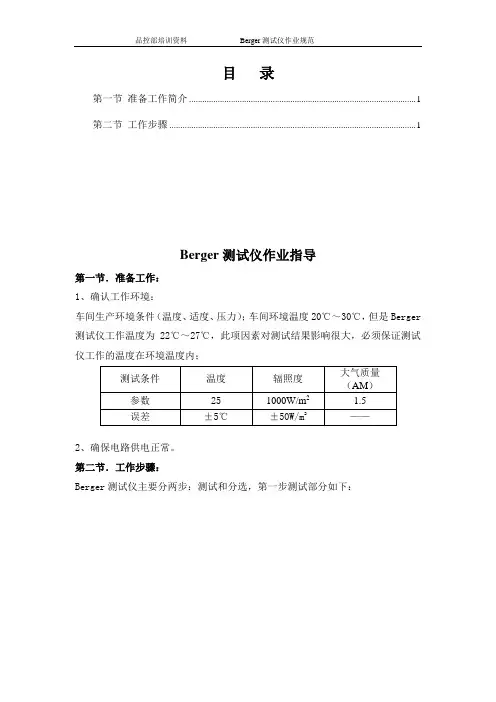
目录第一节准备工作简介 (1)第二节工作步骤 (1)Berger测试仪作业指导第一节.准备工作:1、确认工作环境:车间生产环境条件(温度、适度、压力);车间环境温度20℃~30℃,但是Berger 测试仪工作温度为22℃~27℃,此项因素对测试结果影响很大,必须保证测试仪工作的温度在环境温度内;测试条件温度辐照度大气质量(AM)参数251000W/m2 1.5误差±5℃±50W/m2 ——2、确保电路供电正常。
第二节.工作步骤:Berger测试仪主要分两步:测试和分选,第一步测试部分如下:㈠.测试部分1.进入软件界面在电脑桌面上双击Scload软件图标,如右图。
2.进入Scload软件主界面如右图所示。
3.各个菜单简介,如右图。
①菜单栏File、view、Graph、Measurements、Auto Mode、Settings,分别对应文件:视图、图表、测量、自动模式、设置。
②快捷栏分别是新建、打开、保存、预览、打印、图标选择、参数设置、手动调试、手动测试、自动测试。
③界面测试类型。
菜单栏快捷栏④电性能参数如右图。
4.片盒分布图各个参数具体如图。
电性能参数T 测试温度Uoc 开路电压E 测试光强Isc 短路电流Pmpp最大输出功率FF 填充因子Umpp 最大工作电压Rs 串联电阻Impp 最大工作电流Rsh 并联电阻Eff 转换效率Irev1 反向漏电电流(加10v反偏电压时)Irev2反向漏电电流(加12v反偏电压时)㈡.进入自动工作模式1.在菜单Settings 下的Classification中的Open中选择测试程序,如右图。
2.选择测试数据保存路径。
在Settings中选择Configuration;选择程序选择数据保存路径3.然后在弹出的对话框中选择Database,点击Browse选择保存路径。
(需注意选择的数据库文件必须是复制系统开的,不得自己新建)进入自动模式4.以上操作完成后,需转入自动测试模式时,应点击“快捷栏”红色自动测试按弹出MeasurementParameters 栏框,并进行修改为当天生产的时期然后再确认生产中的测试电池片型号是否与实物电池片型号相符合。
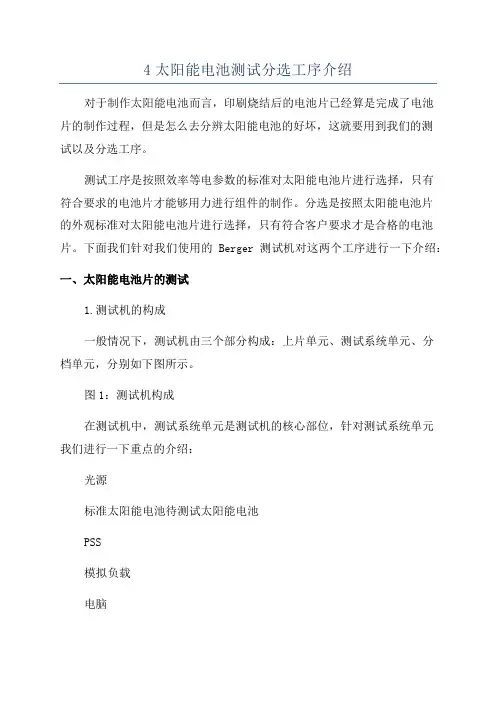
4太阳能电池测试分选工序介绍对于制作太阳能电池而言,印刷烧结后的电池片已经算是完成了电池片的制作过程,但是怎么去分辨太阳能电池的好坏,这就要用到我们的测试以及分选工序。
测试工序是按照效率等电参数的标准对太阳能电池片进行选择,只有符合要求的电池片才能够用力进行组件的制作。
分选是按照太阳能电池片的外观标准对太阳能电池片进行选择,只有符合客户要求才是合格的电池片。
下面我们针对我们使用的Berger测试机对这两个工序进行一下介绍:一、太阳能电池片的测试1.测试机的构成一般情况下,测试机由三个部分构成:上片单元、测试系统单元、分档单元,分别如下图所示。
图1:测试机构成在测试机中,测试系统单元是测试机的核心部位,针对测试系统单元我们进行一下重点的介绍:光源标准太阳能电池待测试太阳能电池PSS模拟负载电脑市电图2:测试系统单元构成图3:测试机探针图2.Berger测试系统的原理:测试系统的原理是通过模拟1.5AM1000W/cm2太阳光脉冲照射PV电池表面产生光电流,光电流流过可编程式模拟负载,在负载两端产生电压,负载装置将采样到的电流、电压、标准片检测到的光强以及感温装置检测到的环境温度值,通过RS232接口传送给监控软件进行计算和修正,得到PV电池的各种指标和曲线、然后根据结果进行分类和结果输出。
测试的原理图如:图4所示:其中PV为待测电池片,V为电压测量装置,I为电流测量装置,RL为可编程式模拟负载,它的值可在0.003-400Ω之间变化。
图4:Beger测试系统测试原理图3.太阳能电池标准测试前提介绍在太阳能电池的标准测试中,有三个前提因素,即标准太阳光谱为AM1.5,温度为25℃,光强为1000W/M2。
当测试数据不是在这个范围时,所测得的数据都是不准确的。
下面我们针对这几个前提得到含义以及影响分别介绍一下:所谓光谱为AM1.5,即指的是1.5个大气质量。
大气质量被定义为光穿过大气的路径长度,长度最短时的路径(即当太阳处在头顶正上方时)规定为“一个标准大气质量”。
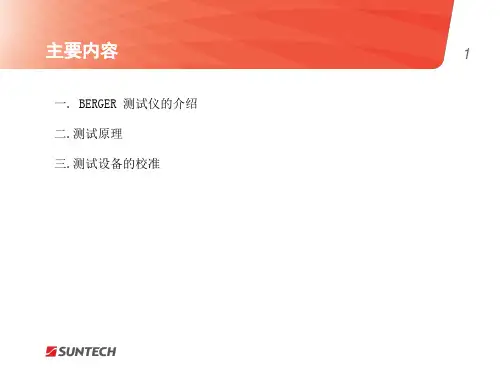
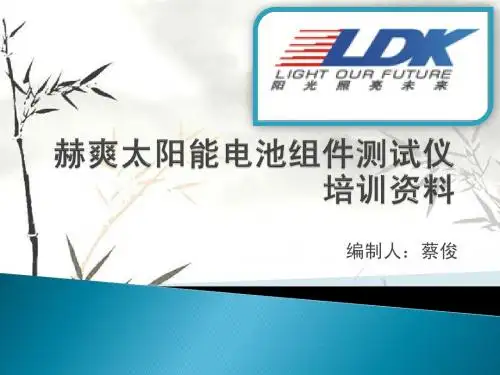
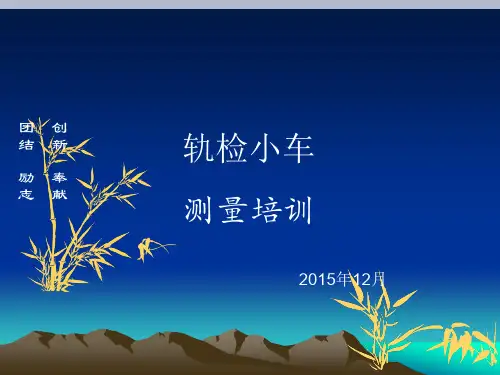
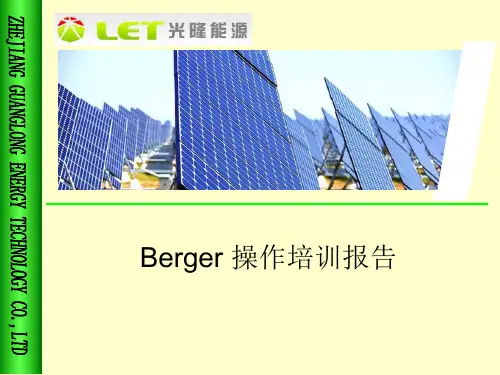
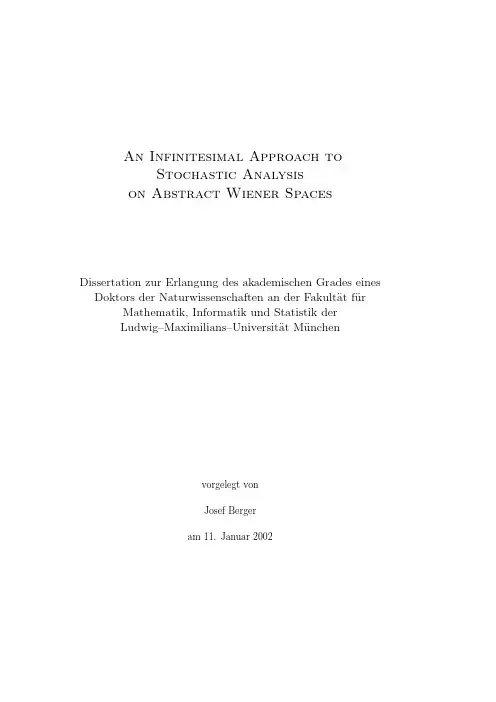
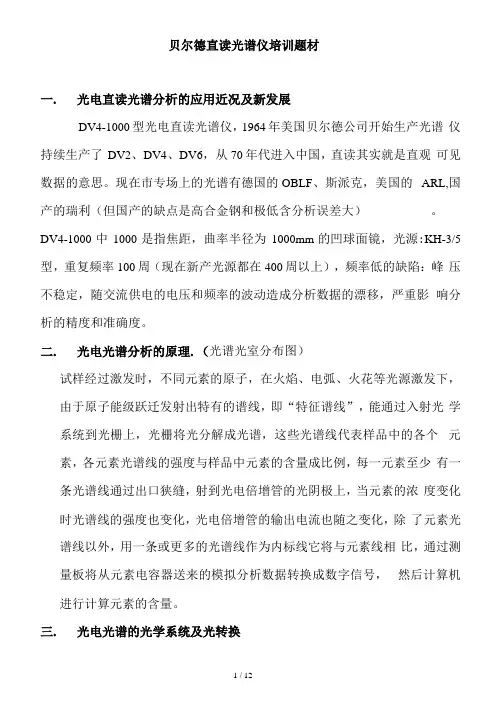
贝尔德直读光谱仪培训题材一. 光电直读光谱分析的应用近况及新发展DV4-1000型光电直读光谱仪,1964年美国贝尔德公司开始生产光谱仪持续生产了DV2、DV4、DV6,从70年代进入中国,直读其实就是直观可见数据的意思。
现在市专场上的光谱有德国的OBLF、斯派克,美国的ARL,国产的瑞利(但国产的缺点是高合金钢和极低含分析误差大)。
DV4-1000中1000是指焦距,曲率半径为1000mm的凹球面镜,光源:KH-3/5 型,重复频率100周(现在新产光源都在400周以上),频率低的缺陷:峰压不稳定,随交流供电的电压和频率的波动造成分析数据的漂移,严重影响分析的精度和准确度。
二. 光电光谱分析的原理.(光谱光室分布图)试样经过激发时,不同元素的原子,在火焰、电弧、火花等光源激发下,由于原子能级跃迁发射出特有的谱线,即“特征谱线”,能通过入射光学系统到光栅上,光栅将光分解成光谱,这些光谱线代表样品中的各个元素,各元素光谱线的强度与样品中元素的含量成比例,每一元素至少有一条光谱线通过出口狭缝,射到光电倍增管的光阴极上,当元素的浓度变化时光谱线的强度也变化,光电倍增管的输出电流也随之变化,除了元素光谱线以外,用一条或更多的光谱线作为内标线它将与元素线相比,通过测量板将从元素电容器送来的模拟分析数据转换成数字信号,然后计算机进行计算元素的含量。
三. 光电光谱的光学系统及光转换1 / 121.罗兰圆(270个出射狭缝),凹面光栅光学系统(其实与我们的光盘CD相适),主要起到光谱线的分散和折射。
使各元素的谱线分别射信对应的光电倍增管的光阴上。
2.光电倍增管的光电转换(能将光谱线射至光阴上产生的光电,放大到几百万倍,以达到测量系统所要求的电流值,此电流可通过同轴电缆送到元素板上进行换算。
)四.用好光电光谱仪的操作要点及注意事项1..光谱仪的外围条件1).仪器的周围不应有振动,不受阳光的直接照射,散热(风扇),机房温度控制在23 ±2℃,温度(有除湿器,<60,不然会引起一些电器元件短路烧坏),应有良好的地线越小越好,接地电阻<4。
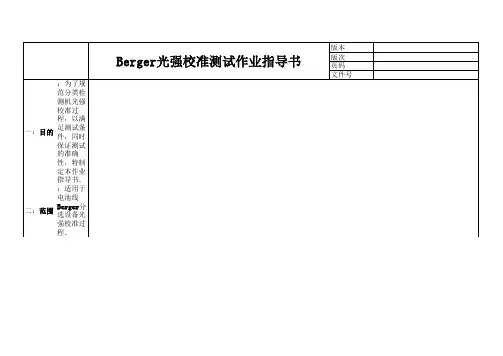
版本版次Berger光强校准测试作业指导书页码文件号一:目的:为了规范分类检测机光强校准过程,以满足测试条件,同时保证测试的准确性,特制定本作业指导书.二:范围:适用于电池线Berger分选设备光强校准过程.三:确认:确认时机,每班上班前确认,每两小时确认一次,确认的间隔误差不得超过20分钟.四:校验前准备I:校准前分类检测机测试过程检查;II:校准前台面检查;1:T为温度,其温度范围为25±2℃,E为幅照,其幅照强度范围在1000±50W/m2 1:检查探针是否有倾斜,损坏现象.2:Voc为所测电池片的开路电压,一般在0.60V-0.62V, Isc为短路电流,一般 2:二级标片使用前检查是否完好,是否在有效期内,如果不不低于5.0A.在有效期内及时更换.3:Rs为所测电池片的串联电阻,一般在0.004-0.008欧,Rsh为所测电池片的并 3:校准操作之前先检查一下探针与电池片接触是否良好,光联电阻,一般大于10欧.强幅照标片上面有无异物遮盖.4:FF为所测电池片的填充因子,一般在75%-77%.版本版次Berger光强校准测试作业指导书页码文件号五:操作步骤说明:说明:说明: 1:点击分检机上的Start/Stop按扭,注意 1:在ASYS分检机器的电脑操作界面上点击左 1:按下自动运行模式后显示以上图片界面显示屏上的操作状态,上面一个为自动运行状上角的键"Operation mode AUTOMATIC"(自动运(手动模式)下的"Service"键态,下面一个为停止状态.行模式).步骤1 暂停机器运行,先暂停扇叶运行,后暂停测试台面上的履带运行版本版次页码文件号五:操作步骤说明:说明:1:接着上一个操作后显示屏上显示为上图,之后按一下"Manual mode"键,再按左上角的 把电池二级标准片放到测试台面的时候要Operation mode STOPPED"键,测试机测试台面下的履带将停止.注意手法,速度不能过快.步骤1 暂停机器运行,先暂停扇叶运行,后暂停测试台面上的履带运行Berger光强校准测试作业指导书步骤2:将电池二级标准片放到测试台面Tester 键版本版次页码文件号五:操作步骤说明:说明:二级标准放到测试台面时要注意探针是否能 先点击步骤1中的Tester键后再按"Close centering"键(先把片子夹在中间,加紧),再全部压到电极,在放标片时要注意标片要靠在下点击"Close the Probes"键(探针压下),这两部一定要注意先后顺序不能弄错,如果顺序错面一面(靠自己一面).了就会把标片弄碎,完了之后在看一下探针是否已经压到标片的两条主栅线上,有没有歪斜.步骤2:将电池二级标准片放到测试台面Berger光强校准测试作业指导书步骤3:探针下压,注意操作步骤的先后顺序版本版次页码文件号五:操作步骤说明:1,机器停止后转移到测试电脑界面,先点击绿色测试键一 次。
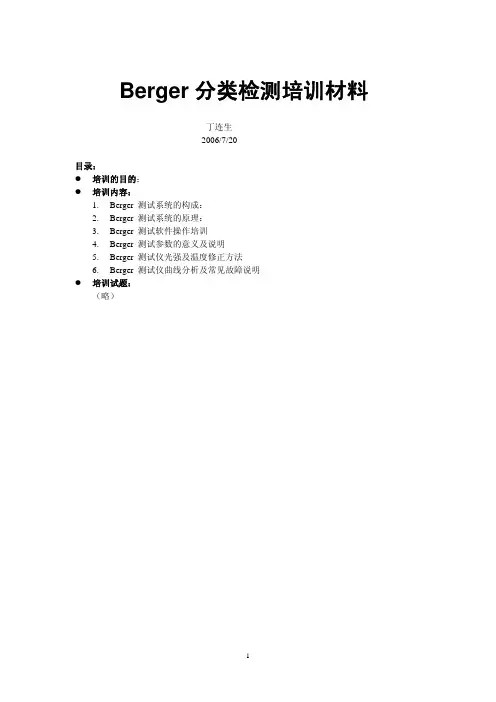
Berger分类检测培训材料丁连生2006/7/20目录:z培训的目的:z培训内容:1.Berger 测试系统的构成:2.Berger 测试系统的原理:3.Berger 测试软件操作培训4.Berger 测试参数的意义及说明5.Berger 测试仪光强及温度修正方法6.Berger 测试仪曲线分析及常见故障说明z培训试题:(略)一.培训目的:通过此次培训,使大家了解测试系统的结构,明确测试系统的原理,掌握测试软件的使用与操作,掌握光强校正及温度校正的方法,并具备一定的测试分析能力。
二. 培训内容:1.Berger 测试系统的构成:测试系统图 1测试针架图 22.Berger 测试系统的原理:本系统通过模拟1.5AM1000W/cm2太阳光脉冲照射PV电池或组件表面产生光电流,光电流流过可编程式模拟负载,在负载两端产生电压,负载装置将采样到的电流、电压、标准片检测到的光强以及感温装置检测到的环境温度值,通过RS232接口传送给监控软件进行计算和修正,得到PV电池的各种指标和曲线、然后根据结果进行分类和结果输出。
3.Berger 测试软件操作培训:3. 1 分类文件的建立和修改。
3.11 在SCLoad 软件菜单中选择Settings -----Operating Mode….(图 3)图33. 12 在Operating Mode 中选择Manager 后按 OK(图 4).图 4 图 53. 13 在Password 中不需输任何内容,直接按 OK(图5).图 63. 14 在菜单Settings 中选择 Classification 及其 New 子菜单(图 6)。
3. 15 按 OK 创建新的分类文件(图7)。
图7 图 83. 16 输入新分类文件名,并保存(图 8)。
3. 17 在分类文件的Class 项目中点击 Add , 根据要求输入分类档次(Class)的名称,其中一个档次必须为垃圾档 (TRASH),并给每个档次分配一个存放盒(Bins , 16 个分检盒中的一个)(图 9)。
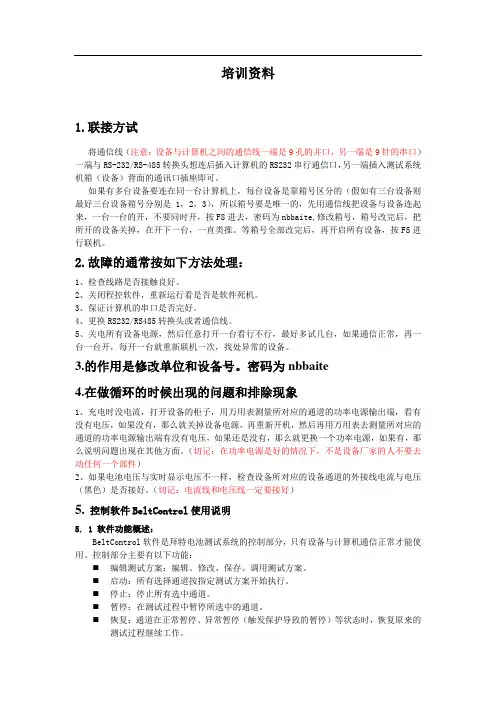
培训资料1.联接方试将通信线(注意:设备与计算机之间的通信线一端是9孔的并口,另一端是9针的串口)一端与RS-232/RS-485转换头想连后插入计算机的RS232串行通信口,另一端插入测试系统机箱(设备)背面的通讯口插座即可。
如果有多台设备要连在同一台计算机上,每台设备是靠箱号区分的(假如有三台设备则最好三台设备箱号分别是1,2,3),所以箱号要是唯一的,先用通信线把设备与设备连起来,一台一台的开,不要同时开,按F8进去,密码为nbbaite,修改箱号,箱号改完后,把所开的设备关掉,在开下一台,一直类推。
等箱号全部改完后,再开启所有设备,按F5进行联机。
2.故障的通常按如下方法处理:1、检查线路是否接触良好。
2、关闭程控软件,重新运行看是否是软件死机。
3、保证计算机的串口是否完好。
4、更换RS232/RS485转换头或者通信线。
5、关电所有设备电源,然后任意打开一台看行不行,最好多试几台,如果通信正常,再一台一台开,每开一台就重新联机一次,找处异常的设备。
3.的作用是修改单位和设备号。
密码为nbbaite4.在做循环的时候出现的问题和排除现象1、充电时没电流,打开设备的柜子,用万用表测量所对应的通道的功率电源输出端,看有没有电压,如果没有,那么就关掉设备电源,再重新开机,然后再用万用表去测量所对应的通道的功率电源输出端有没有电压,如果还是没有,那么就更换一个功率电源,如果有,那么说明问题出现在其他方面。
(切记:在功率电源是好的情况下,不是设备厂家的人不要去动任何一个部件)2、如果电池电压与实时显示电压不一样,检查设备所对应的设备通道的外接线电流与电压(黑色)是否接好。
(切记:电流线和电压线一定要接好)5.控制软件BeltControl使用说明5. 1 软件功能概述:BeltControl软件是拜特电池测试系统的控制部分,只有设备与计算机通信正常才能使用。
控制部分主要有以下功能:⏹编辑测试方案:编辑、修改、保存、调用测试方案。
China’s new bilateral investment treaty programme: Substance, rational andimplications for international investment law makingAxel BergerGerman Development Institute (DIE)Paper prepared for the American Society of International Law International Economic Law Interest Group (ASIL IELIG) 2008 biennial conference “The Politics of InternationalEconomic Law: The Next Four Years”, Washington, D.C., November 14-15, 2008Abstract:This article aims at empirically investigating the evolution of China’s BIT policy since the early 1980s and compares it with current developed country approaches. Analysing the development of substantive and procedural investment protection provisions, it argues that China has pro-actively initiated a remarkable change of its formerly restrictive BIT policy towards a liberal approach. Since 1998, Beijing is negotiating BITs that contain comprehensive investor-state dispute settlement provisions. China even abandoned its hostile stance on national treatment of foreign investors. Notwithstanding existing reservations towards unrestricted national treatment, the current Chinese model agreement is comparable to the admission model BIT adopted by European countries. The prospects of the proposed Sino-US BIT, however, are looking rather bleak. This is mainly due to fundamental differences with respect to the parties view on the protection of FDI in the pre-establishment phase and the current political environment in the US that accentuates national security concerns with regard to foreign investors from developed and emerging countries. Contact:Axel BergerGerman Development Institute (DIE)Tulpenfeld 653113 Bonn, GermanyT: +49(0)228 94927-235F: +49(0)228 94927-130Axel.Berger@die-gdi.de1 IntroductionChina’s rise as an economic player is causing significant power shifts in the world economy.1 Its strength as a low cost manufacturer helps to supply global markets with cheap products and simultaneously increases the global demand for commodities. This growing economic presence – in accordance with the classical argument by Paul Kennedy on “The Rise and Fall of the Great Powers“2 – consequentially augments China’s political influence in international relations.A phenomenon demonstrating China’s economic rise is its growing outward foreign direct investments (FDI). They have recently been discussed widely in the literature as part of a larger trend of developing countries emergence as sources of investments.3 Less visible in the literature is a second trend, namely Beijing’s growing acceptance of international investment agreements as legal instruments for the protection of FDI.4 Most notably, China has been negotiating bilateral investment treaties (BIT) since the end of the 1990s that include far reaching substantive and procedural investment protection. This new policy was a turning away from China’s traditional stance towards international investment law that accentuated the host country’s sovereign right of regulating foreign investments – a policy typical for FDI-importing countries.Against this background this paper aims at empirically investigating the evolution of China’s BIT policy since the early 1980s and compares it with current developed country approaches. After the introduction, chapter 2 will give an overview of the development and substance of today’s global BIT system. Chapter 3 describes the rise of China as a home country for outward FDI and its strategic determinants. Chapter 4 will outline China’s traditional restrictive BIT approach. Chapter 5 argues that China is negotiating liberal BITs with developing as well as developed countries since 1998 that are similar to the European model treaty. Chapter 6 will summarise the main findings and give a preliminary assessment of the background and prospects of success of the ongoing BIT negotiations between China and the US.2 Protection of foreign investment through bilateral investment treatiesThe global governance system for FDI is made up of a dense and complex network of international investment agreements that are usually concluded on a bilateral basis. Bilateral investment treaties (BIT) hence form the most important legal institution for the governance1 See e.g. Kaplinsky and Messner (2008).2 Kennedy (1987).3 See e.g. Sauvant (2005); UNCTAD (2006); Aykut and Goldstein (2006); Broadman (2007); Pamlin and Baijin (2007); UNCTAD and UNDP (2007).4 See e.g. Kong (2003); Cai (2006; 2007); Chen (2006; 2007); Braun and Schonard (2007); Rooney (2007); Berger (2008a); Heymann (2008).of FDI.5 They are defined as agreements that “protect investments by investors of one state in the territory of another state by articulating substantive rules governing the host state’s treatment of the investment and by establishing dispute resolution mechanisms applicable to alleged violations of those rules.”6 The aim of BIT contracting parties is to promote economic cooperation, believing that enhanced legal protection will ultimately result in increasing FDI flows fostering economic development processes in host as well as home countries. BITs, however, do not allow for direct regulatory measures by host states potentially increasing the developmental impact of FDI. Furthermore, the results of quantitative econometric studies on the effectiveness of BIT in increasing FDI flows are mixed and lead to an inconclusive picture.7The concept of legalisation as developed by Abbott et al. will be used to describe the characteristics of the global BIT system.8 Legalisation is a special form of institutionalisation – understood as the expansion of rules, norms and decision-making procedures that influences expectations, interests and behaviour of actors – and “represents the decision […] to impose international legal constraints on governments.”9 The degree of legalisation varies substantially from one issue area to another and within issue areas over time. Along three main criteria – obligation, precision and delegation – the degree of legalisation can be described as a continuum ranging from soft to hard law. In this respect,“[h]ighly legalized institutions are those in which rules are obligatory on parties through links to the established rules and principles of international law, in which rules are precise (or can be made precisethrough the exercise of delegated authority), and in which authority to interpret and apply the rules hasbeen delegated to third parties acting under the constraints of rules.”10The current institutional structure in the area of international investment protection is highly legalised according to the above mentioned characteristics. With respect to the first criteria, modern BITs entail rules that impose binding obligations on the parties which can be enforced through investor-state dispute settlement. Although BIT texts are often drafted in an open and imprecise manner – usually encompassing no more than ten pages – they can be described as hard law as they delegate the authority of interpretation and implementation to transnational 5 See e.g. Dolzer and Stevens 1995; UNCTAD 1998, 2007b. Beyond BITs, investment rules are increasingly being incorporated in double taxation treaties and economic integration agreements like free trade agreements. See UNCTAD (2000; 2006b). On the multilateral level, investment-related rules are mainly incorporated into single WTO agreements such as the General Agreement on Trade in Services (GATS), the Agreement on Trade-Related Investment Measures (TRIMs) and the Agreement on Trade-Related Aspects of Intellectual Property Rights (TRIPS). Among member countries of the OECD the whole spectrum of international investment relations is governed in the Code of Liberalization of Capital Movements (CCM) and the Declaration on International Investment and Multinational Enterprises (DIIME). See Berger (2008a): 3-5 for an overview.6 Vandevelde (2000): 469–470.7 See e.g. Hallward-Driemeier (2003) and Tobin and Rose-Ackermann (2005) that find no or only little evidence for the effectiveness of BITs. Banga (2003), Neumayer and Spess (2005) and Busse et al. (2008), instead, arrive at a positive relationship between BIT and FDI.8 Abbott et al. (2000).9 Goldstein et al. (2000): 386.10 Abbott et al. (2000): 418.arbitration bodies.11 BITs notably grant foreign investors direct legal personality under international law.12 Without being obliged to submit a claim to domestic courts, foreign investors may sue host countries directly before a transnational tribunal and thus limit national legal sovereignty: “once in force, the role played by non-state actors in the regime’s enforcement mechanisms can be of greater significance than the role played by states.”13 Modern BITs usually provide foreign investors with high levels of substantive and procedural protection. They follow a liberal approach to international investment protection.14 Liberal, i.e. highly legalised, BITs include broad definitions of investment, comprehensive absolute and relative standards of treatment, provisions on the compensation for expropriation and the free transfer of funds as well as unrestricted investor-state dispute settlement mechanisms. While providing high levels of legal protection for foreign investors, liberal BITs limit host countries’ regulatory discretion to restrict national laws and regulations on the entry and operation of multinational enterprises (MNE). The utilisation of liberal investment agreements tends to lead to a more open and less regulated global investment regime. The restrictive approach, in contrast, includes several regulations limiting the substantive and procedural protection of foreign investments and thereby preserves the sovereign right of host states to maintain national laws and regulations on the entry and operation of foreign investors in accordance with national development strategies.Throughout the colonial period foreign investments in developing countries were protected mainly by customary international law. The home state – not the foreign investing company – was the single party allowed to seek redress of an alleged injury by the host state and only breaches of minimum standards of the treatment of foreign investors gave rise to a claim under such law of state responsibility. Hence, customary international investment law provided very little protection.15 The earliest rules to protect FDI flows were incorporated in treaties on friendship, commerce and navigation (FCN) first concluded by the US in large numbers during the late 18th century. These early FCN treaties, however, only partially contained rules on investment. Post-Second World War FCN treaties used to be more investment specific, containing a number of substantive and procedural rules for investment protection that were later adopted in BITs.16The first BIT was signed between Germany and Pakistan in 1959, in 2006 their total number has been accounted to more than 2,500 treaties worldwide.17 Throughout the 1970s and 1980s 11 Keohane et al. (2000): 485 state that in …transnational dispute resolution, […] access to courts and tribunals and the subsequent enforcement of their decisions are legally insulated from the will of individual national governments. These tribunals are therefore more open to individuals and groups in civil society.”12 See Peterson (2005): 8.13 Schneidermann (2004): 68.14 Both the liberal and the restrictive BIT approaches are understood as ideal types. In the Weberian sense ideal types are “formed by the one-sided accentuation of one or more points of view and by the synthesis of a great many diffuse, discrete, more or less present and occasionally absent concrete individual phenomena, which are arranged according to those one-sidedly emphasized viewpoints into a unified analytical construct”, see Weber (1997): 88.15 See Weil (2001).16 See Vandevelde (1992); Sornarajah (1994).17 See UNCTAD (2007a).BITs slowly spread, with roughly 20 treaties being signed annually mainly between European and developing countries. With the decision of the US to adopt BITs as a foreign investment protection device their number started to increase sharply. When the block of developing countries decided to give up their struggle for a “New International Economic Order”, including the right of host states to expropriate foreign companies’ investments in the natural resource sector, the number of BITs rose even further since developing countries started to compete in capturing a share of global FDI flows, facing the dilemma of either signing BITs that privileged the contracting party exporting FDI or possibly losing FDI to other countries increasing their competitive advantage.18Although BITs are generally negotiated on a reciprocal basis, providing the same level of legal protection for both signatories, they are in fact agreements between a FDI-exporting and a FDI-importing country. The actual level of investment protection found in BIT provisions, therefore, is a function of the expectations of both parties and their respective bargaining power. Due to the fact that developing countries depend on FDI inflows as a source of external financing they usually agree to the model agreements put forward by FDI-exporting countries. The level of legalisation in international investment law has therefore grown strongly since the early 1990s. Only large developing countries like China, India and Brazil were able to refrain from signing liberal BITs.19BIT contents today show a considerable uniformity with regard to general provisions on substantive and procedural protection of foreign investments. The main difference found in liberal BITs is the degree to which they protect investments already in the pre-establishment phase – i.e. before the FDI project has been admitted through the host country’s authorities in accordance with national laws and regulations:“This approach consists in providing foreign investors with national treatment and MFN treatment not only once the investment has been established, but also with respect to the establishment. This means that investors of one party will receive treatment not less favourable with regard to investing in the territory of the other party than domestic investors and investors of any other third country.”20The admission model BIT that has been adopted by European countries and developing countries such as China alike provides investment protection only after the admission of the FDI project. The pre-establishment model, applied by the US from the 1980s onwards, by Canada from the mid 1990s onwards, and by Japan from the beginning of this century entails provisions on the protection of FDI even before their admission. These treaties restrict the screening powers of host states in the pre-establishment phase and their sovereignty in regulating the entry of foreign investors, leading to a liberalisation of host countries’ regulatory systems.2118 See e.g. Guzman (1998) and Elkins et al. (2006).19 China’s traditional restrictive BIT approach will be described in more detail in section 4.20 UNCTAD (2007b): 22.21 Gugler and Tomsik (2007); UNCTAD (2007b): 23.3 China’s emerging outward foreign investmentsThe growth of Chinese outward FDI is the latest stage of an economic growth process that started in the late 1970s with the Chinese leadership’s decision to gradually open up the economy. During the last three decades China has been mostly perceived as the workbench of the global economy, receiving large inflows of foreign investments in export oriented industries. China is traditionally seen as the largest developing host country of global FDI. It accounted for a total stock of US$292 billion in 2006 and attracted FDI flows amounting to US$69 billion in 2006. With China still being a net FDI-importing country, it has recently become an important source country for foreign investments, too. Outward FDI flows grew particularly strongly from a low basis in the first half of the 1990s, before slowing down toward 2000 and increasing again thereafter. Especially noteworthy is the sharp increase of outward FDI flows from US$12 billion in 2005 to US$16 billion in 2006. China is currently the 7th largest foreign investor among developing countries in terms of stocks. Accumulated outward FDI, having been marginal during the first half of the 1980s, have since grown strongly and reached US$73 billion in 2006.22Apart from the strong growth of foreign investments by Chinese enterprises in absolute terms, outward FDI is still surpassed by the volume of inward FDI. However, the outward/inward FDI ratio – an indicator which refers to what Dunning has called a “country’s net international direct investment position”23 – shows that outflows from China grew more rapidly than inflows during the last years, demonstrating that China’s overall importance as an FDI-exporting economy is evolving. China’s total outward/inward FDI ratio has been growing strongly – although from a low basis – since 2002 and stood at 17 in 2005. Notably, the outward/inward FDI ratio towards developing countries is almost double the overall ratio and roughly six times higher than the ratio towards developed countries. This summary of the relative distribution of reciprocal FDI flows suggests that China’s interest in strong legal investment protection through BITs is especially pronounced towards developing countries.24 The geographical distribution of Chinese outward FDI flows has undergone a major shift since the beginning of the 1990s. While developed countries were its main destination during the 1980s, Chinese outward FDI today is predominantly conducted on a South-South basis;i.e. its main recipients are developing countries. Apart from this general observation, disaggregated Chinese outward FDI flows have to be interpreted with great caution. Statistical problems occur with regard to the treatment of round-tripping FDI and foreign investments in offshore-financial centres.25 Against this background, the following figures are indicative only. A compilation of data from various editions of the “Almanac of China’s Foreign Economic Relations and Trade”, published annually by the Chinese Ministry of Commerce (MOFCOM), shows that Asia has been the main destination of Chinese FDI during the period of 2003 to 2005, attracting 38 per cent of all Chinese outward FDI. During the same period, Latin America absorbed 32 per cent and Europe 15 per cent. Africa ranked fourth, accounting22 UNCTAD (2007a): 299-306.23 Dunning (1981): 30.24 See Berger (2008a): 11-15.25 See Berger (2008a): 8-9.for 7 per cent of Chinese outward FDI even ahead of North America’s 4 per cent. Oceania attracted 3 per cent of Chinese outward FDI during the respective period.26 With regard to their sectoral distribution, Chinese outward FDI are mainly conducted in the manufacturing, resource-seeking and the IT and software sectors.27Chinese outward FDI is bound to increase in the future. Reasons for this dynamic can be found in political and business sector drivers. With respect to the latter, increasing foreign investments is a result of push factors at the domestic level and pull factors at the global level. On the one hand, in the wake of the accession to the World Trade Organization (WTO) in 2001 and the subsequent need to relocate mature industries to lower wage economies, especially to neighbouring Asian countries, Chinese companies are confronted with a growing competitive pressure on the domestic market.28 On the other hand Chinese companies are increasingly taking advantage of the global business environment’s opportunities. In contrast to the traditional perspective found in the business literature that attributes (Western) multinationals’ internationalisation to a previous accumulation of competitive advantages (asset exploitation), recent studies suggest that multinationals from emerging economies tend to internationalise in order to build up competitive advantages (asset augmentation).29 Recent large merger & acquisitions (M&A) emphasize that this development applies especially to Chinese multinationals. They invest abroad in order to acquire scarce advanced technologies, brand names, distribution networks and managerial know-how,30 and as Wang argues, Chinese enterprises frequently use outward FDI as a means to gain access to developed country markets often protected by trade barriers of regional blocs.31Large Chinese companies rely strongly on their government’s support when intent on investing in strategically important sectors and countries, especially in developing countries. The current Chinese “Going Global” strategy aims at encouraging Chinese companies’ foreign investments abroad. This strategy, which was first announced in 1998 and was embedded in the Tenth Five-Year Plan for National Economy and Social Development in 2001, marked the transition of Beijing’s outward FDI policy from regulations to encouragement.32 The build-up of a number of global champions capable of competing on the global market has since been an explicit industrial policy goal reconfirmed by the “Going Global” strategy. The current government gives priority to resource exploration projects, the export promotion of domestic technologies, overseas research and development as well as M&As enhancing the international competitiveness of Chinese enterprises, accelerating their foreign market presence.3326 See Berger (2008a): 11-12.27 MOFCOM data for the year 2005 shows the following sectoral distribution of Chinese OFDI: manufacturing (30 per cent), resource-seeking (29.8 per cent), IT and software (27.3 %), business services (5.4 per cent), retail (3.4 per cent), communication (2.2 per cent) and others (5.4 per cent), cited in Lunding (2006): 2.28 UNCTAD (2004): 25, 27.29 See e.g. Mathews (2002; 2006).30 See Lunding (2006): 4.31 Wang (2002): 202.32 See Cai (2006): 626.33 See UNCTAD (2006): 210.The growth of Chinese outward FDI in recent years emphasises the need to comprehend China not only as an FDI-importing country, but increasingly as an FDI-exporting economy, too. The reconfiguration of Chinese FDI flows is thought to have led to a significant change of Beijing’s stance on the protection of foreign investments from a restrictive to a liberal approach. Before chapter five will investigate China’s new liberal BIT policy, it will be necessary to describe the main features of its old restrictive approach in the following chapter.4 China’s traditional approach towards international investment lawThe overall economic reform process which started in 1978 led to significant changes in China’s stance on international investment law. During the first three decades of self-imposed isolation from the world market (all through the 1950s until the late 1970s), Beijing adopted a hostile approach towards international investment law and the protection of FDI. One major rationale for this policy can be found in China’s adherence to the Marxist doctrine of rejection of private property. Another rationale for China’s hostile stance on international investment protection lay in China’s experience of colonial rule and foreign interventions. International (investment) law had hence been viewed by Chinese politicians and scholars as a means “used by the imperialists and hegemonists […] to carry out aggression, oppression and exploitation”.34 Its validity, had therefore been rejected. China’s hostile approach towards foreign investments and its import-substitution strategy notably coincided with most developing countries’ attempts to establish a New International Economic Order. In sum, China’s policy accentuated the sovereign right to control the entry of FDI, regulate foreign investors and nationalise foreign property without being obliged to compensation. Consequently, China signed no BIT until 1982 when it concluded a first treaty with Sweden.35In June 2007, China had already concluded 120 BITs,36 making it the second largest contracting party to BITs worldwide.37 This increase in the sheer number of agreements since the early 1980s reveals Beijing’s growing acceptance of international investment law. With regard to actual treaty provisions and their effectiveness in protecting foreign investments, however, it takes two different stages important to be examined in order to gain a clear understanding of the historical evolution of China’s BIT approach. In 1998 Beijing changed its international investment policy from a restrictive mode accentuating the regulation of inward FDI to a liberal approach emphasising the encouragement of outward Chinese FDI.38 This remarkable change in China’s international investment policy making has been ascribed by a number of scholars to China’s evolution from a mere FDI-importing country to an economy that – while still receiving large amounts of foreign investments – is increasingly investing abroad. China is becoming a FDI-exporting economy.34 Kong (2003): 108.35 Kong (2003): 109.36 See the Investment Treaties Online database provided by UNCTAD, available at: /templates/DocSearch____779.aspx, accessed 16 October 2008.37 Germany has singed 136 BITs until June 2007.38 See e.g. Cai (2006): 626.The remaining part of this chapter will investigate the main first-generation BIT provisions that characterise the restrictive approach, while the next chapter will examine the characteristics of China’s second-generation of BITs, comparing them with both the European admission model and the US pre-establishment model.Chinese BITs contain all standard provisions found in global BIT practice. They usually start with a preamble stating the intention of creating “favourable conditions for investments of investors of one Contracting Party in the territory of the other Contracting Party” aiming at promoting mutual investments. The BIT is meant to “intensify the economic cooperation of both States on the basis of equality and mutual benefit.”39 The general pre-1998 (as well as the post-1998) BIT adopts the widespread admission model. Accordingly, absolute and relative standards of treatment of FDI in Chinese BITs are only in force once the investment has been admitted by the host countries’ government. Furthermore, Chinese BITs entail provisions on the definition of investment and the investor, their treatment, expropriation, the transfer of funds, compensation for losses due to war, civil strive and the settlement of disputes. In the following, the main emphasis will be laid on relative and procedural investment protection provisions. They are for one part generally acknowledged to represent the most important elements of BITs and they are furthermore central to the understanding of the evolution of China’s approach.Throughout the 1980s and 1990s China adopted an international investment policy approach characteristic of any given FDI-importing developing country. China’s restrictive policy adopted the so-called “three guiding principles” of international economic co-operation and exchange. China’s authorities upheld their sovereignty to screen and regulate FDI, insisted on the equality and mutual benefit of host and home state and referred to the international practice.40 Kong observes that it “is obvious that utilitarianism or even mercantilism has been the driving force behind the investment legislation” and that “China’s attitude towards FDI in this period was rooted in mixed feelings of attraction and aversion.”41 While negotiating BITs in great numbers, the Chinese international investment policy until the late 1990s remained marked by a reluctance to imply strong legal protection to foreign investments.Until 1998, China signed BITs containing serious reservations towards strong substantive as well as procedural protection of foreign investments. With regard to relative standards of treatment of foreign investors, China appeared reluctant to grant national treatment; i.e. not to discriminate between domestic and international investors. The aim of protecting infant industries and especially state-owned enterprises from foreign companies’ competition may serve as an explanation in this regard. A number of BITs with developed countries made an exception and included provisions on national treatment; however, they contained far-reaching qualifications limiting the effective protection of foreign investments. Article 3 (3) of the Sino-UK BIT concluded in 1986 states that:39 See e.g. China-Egypt BIT (1994).40 Kong (2003): 110.41 Kong (2003): 110.。
一、目的:为满足生产线各类电池片测试、分档、包装的准确、有序进行二、范围:适用于生产线ASYS和Baccini印刷机嵌套的Berger测试机分档文件。
三、定义:参考技术文件《电池片分档规范》四、职责:4.1 生产部门负责自动测试时选择正确合适的分档文件,并按照各档位电池片进行分档包装。
4.2 工艺部门编写正确的分档文件五、作业流程图:无。
六、作业内容:Berger测试机测试分档文件共分8类:目录:6.1 单晶125 150对径(CC5M-R150)6.2 单晶125 165对径(CC5M-R165)6.3 多晶125(CC5P)6.4 单晶156 200对径(CC6M3-R200)6.5 单晶156 220对径(CC6M3-R220)6.6 多晶150(CC6PS)6.7 多晶156(CC6P3)6.8 单晶156 ESE(CC6M-R200-ESE)6.9 E-Cell(CC6PE)6.1 单晶125 150对径(CC5M-R150)6.1.1 适用范围适用于单晶125,150对径电池片的转换效率测试6.1.2正常生产测试分档文件名“CC5M-R150-1”,反向电压设置-12V,0V,电池片面积148.58cm2包装说明Bin1-13档,按对应转换效率包装,SS栏标注“1201”;Bin14档,低效片档,需要使用6.1.3低效重测分档文件重新测试;Bin15档,暗电流档,需要使用6.1.4暗电流重测分档文件重新测试;Bin16档,每个批次测完后将该档位的片子进行重测,重测后若仍有分到TRASH档中的电池片,则将这些电池片放入Bin15档,与暗电流片一起处理。
6.1.3 低效片重测分档文件名“CC5M-R150-2”,反向电压设置0V,0V,电池片面积148.58cm2Bin1-15档,按对应转换效率包装,SS栏标注“1201”;Bin16档,TRASH档,每个批次测完后将该档位的片子进行重测6.1.4 暗电流重测分档文件名“CC5M-R150-3”,反向电压设置-7V,-10V,电池片面积148.58cm2Bin1-4档,按对应转换效率包装,SS栏标注“0701”;Bin15档,转换效率栏标注N/A,SS栏标注“0702”Bin16档,TRASH档,每个批次测完后将该档位的片子进行重测,若重测后仍有电池片分入TRASH档则将这些电池片按照Bin15档进行包装。